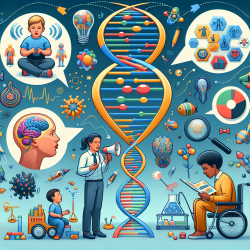Understanding the Power of Disconnectomes in Pediatric Therapy
As a practitioner in the field of speech-language pathology, you are likely familiar with the challenges of addressing neurological impairments in children. The study "Finding Maximally Disconnected Subnetworks with Shortest Path Tractography" offers a novel approach that can significantly enhance your therapeutic strategies. By leveraging this research, we can better understand the intricate brain networks affected by various conditions, leading to improved outcomes for children.
What Are Disconnectomes?
Disconnectomes refer to the representation of damaged or lesioned connections within the brain's structural network. This research introduces a method to accurately and quickly identify these disconnections using shortest path tractography. By understanding which areas of the brain are most affected, practitioners can tailor interventions more precisely.
Implications for Pediatric Therapy
The research highlights the importance of identifying maximally disconnected subnetworks, particularly in cases of stroke or other neurological impairments. For children, this means that we can pinpoint specific areas of disconnection that may be impacting their speech, language, or cognitive abilities. The ability to visualize and quantify these disconnections provides a clearer picture of the child's neurological status, allowing for more targeted therapy plans.
Data-Driven Decisions in Therapy
Incorporating data-driven decisions into your practice ensures that interventions are based on solid evidence. The method described in the research allows for the creation of a normative database of connection probabilities, which can be used to compare a child's brain network against typical development patterns. This comparison can reveal specific areas where intervention is needed, enhancing the effectiveness of therapy.
Encouraging Further Research
While the study provides a robust framework for understanding disconnectomes, it also opens the door for further research. Practitioners are encouraged to explore how these findings can be integrated into existing therapeutic models and to consider conducting their own studies to expand on this knowledge. Collaboration with researchers and other clinicians can lead to innovative approaches that further improve child outcomes.
Practical Application
- Use the disconnectome data to inform your assessment and intervention strategies.
- Collaborate with neurologists or neuroscientists to gain deeper insights into a child's brain connectivity.
- Consider the potential of using this method to monitor progress and adjust therapy plans accordingly.
By embracing these data-driven insights, practitioners can enhance their ability to support children with neurological impairments, ultimately leading to better outcomes. The integration of cutting-edge research into clinical practice not only enriches our understanding but also empowers us to make a tangible difference in the lives of children.
To read the original research paper, please follow this link: Finding maximally disconnected subnetworks with shortest path tractography.










